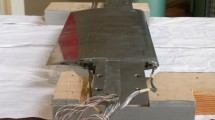Abstract
Within the European project AFLoNext, one of the technological streams is dedicated to the investigation of active flow control (AFC) to increase the robustness of the wing tip design at takeoff conditions, whilst allowing the optimization of aerodynamic efficiency in cruise. AFC is used to delay the wing tip stall, which is caused by vortex breakdown, thus improving the lift to drag ratio and allowing a steeper climb gradient during second segment climb when the landing gear is retracted. The numerical parametric studies of AFC aerodynamic sizing were shared between the involved partners on the basis of actuator location (in the leading edge region or on the upper surface) and actuator types (steady blowing, synthetic jets, pulsed jets). Most of the numerical results have been obtained for steady blowing through continuous or segmented slots. The specific effect of the unsteady means of actuation on the flow topology was also identified. The aim of this study was to take into account industrial requirements defined by Airbus and geometric constraints of AFC actuators arising from the project partners involved in the development of AFC hardware. Some comparisons between the partners’ results are presented, allowing preliminary conclusions to be drawn. The most effective and efficient device turned out to be pulsed blowing through segmented slots located at the leading edge separation line.






















Similar content being viewed by others
Abbreviations
- α :
-
Angle of attack
- C D :
-
Drag coefficient
- Cfx:
-
Longitudinal skin friction coefficient
- C L :
-
Lift coefficient
- C m :
-
Pitching moment coefficient
- Cµ:
-
Blowing momentum coefficient based on wing reference surface
- Cp:
-
Pressure coefficient
- L/D :
-
Lift to drag ratio
- Q :
-
Second invariant of the velocity gradient tensor
- AFC:
-
Active flow control
- AoA:
-
Angle of attack
- CAD:
-
Computer aided design
- CFD:
-
Computational fluid dynamics
- IDDES:
-
Improved delayed detached eddy simulation
- LE:
-
Leading edge
- LES:
-
Large eddy simulation
- PJA:
-
Pulsed jet actuator
- RANS:
-
Reynolds average Navier–Stokes
- SJA:
-
Synthetic jet actuator
- TS:
-
Technology stream
- UHBR:
-
Ultra-high bypass ratio
References
Getting to grips with—aircraft performance, Flight Operations Support & Line Assistance, Customer Services Airbus, and at http://www.smartcockpit.com/aircraft-ressources/Getting_to_Grips_With_Aircraft_Performance.html. Accessed Oct 2013
Flaig, A., Hilbig, R.: “High-lift design for large civil aircraft,” in High-Lift System Aerodynamics, AGARD CP 515, pp. 31.1–31.12 (1993)
Greenblatt, D., Wygnanski, I.: The control of flow separation by periodic excitation. Prog. Aerosp. Sci. 36(7), 487–545 (2000)
Joslin, R.D., Miller, D.N.: Fundamentals and applications of modern active flow control. Progress in astronautics and aeronautics, vol. 231, ISBN 978-1-56347-983-0, AIAA (2009)
Weigel, P., Schüller, M., ter Meer, T., Bardet, M.: Design of a synthetic jet actuator for separation control. In: Proceedings of CEAS2017 conference (2017)
Schlösser, P.: Design of a pulsed jet actuator for separation control. In: Proceedings of CEAS2017 conference (2017)
Ciobaca, V., Wild, J.: Active Flow Control for an Outer Wing Model of a Take-off Transport Aircraft Configuration—A Numerical Study. In: AIAA Paper 2014–2403 (2014)
Ciobaca, V., Wild, J., Bauer, M., Grund, T., Huehne, P., Scholz, P., Stefes, B.: Wind tunnel experiments with active flow control for an outer wing model. In: AIAA Paper 2015-2728 (2015)
Bauer, M., Grund, T., Nitsche, W.: Experiments on active drag reduction on a complex outer wing model. AIAA J 53(7), 1774–1783 (2015)
Detinis, I., Steinbuch, M., Segal, S., Lagutin, M., Seifert, A., Wasserman, M., Levi, Y: Active flow control implementation for mitigating outer wing flow separation. In: 57th Israel Annual Conference on Aerospace Sciences, 15–16 March (2017)
Cambier, L., Heib, S., Plot, S.: The Onera elsA CFD software: input from research and feedback from industry, mechanics & industry, num. 3, Vol. 14, (2013)
Chalot, F., Mallet, M., Ravachol, M.: A comprehensive finite elements Navier–Stokes solver for low and high speed aircraft design. Reno, AIAA94-0814 (1994)
Chalot, F.: Industrial Aerodynamics. Encyclopedia of Computational Mechanics, vol. 3. Wiley, New York (2004)
Gerhold, T.: Overview of the Hybrid RANS Code TAU. MEGAFLOW—Numerical Flow Simulation for Aircraft Design, Vol. 89 of Notes on Numerical Fluid Mechanics and Multidisciplinary Design, Springer, New York, pp. 81–92 (2005)
Ciobaca, V., Wild, J.: An overview of recent DLR contributions on active flow-separation control studies for high-lift configurations. AerospaceLab Journal, Issue 6 “Flow Control: the Renewal of Aerodynamics? (2013)
Ciobaca, V., Kühn, T., Rudnik, R., Bauer, M., Gölling, B., Breitenstein, W.: Active flow separation control on a high-lift wing-body configuration. J. Aircraft 50(1), 56–72 (2013)
Ciobaca,V., Haucke, F., Rudnik, R., Nitsche, W.: Active flow control on a high-lift airfoil: URANS simulations and comparison with time-accurate measurements. In: AIAA Paper AIAA 2013-2795 (2013)
Eliasson, P.: Edge, a Navier–Stokes solver for unstructured grids. In: Proceedings of Finite Volumes applications III, ISBN 1-9039-9634-1, pp. 527–534 (2002)
Acknowledgements
The work described in this paper and the research leading to these results have received funding from the European Community’s Seventh Framework Programme FP7/2007-2013, under Grant agreement n° 604013, AFLONEXT project.
Author information
Authors and Affiliations
Corresponding author
Additional information
Publisher's Note
Springer Nature remains neutral with regard to jurisdictional claims in published maps and institutional affiliations.
This paper is part of a Special Issue on the AFLoNext project, funded by the European Union's FP7 under grant agreement No 604013.
Rights and permissions
About this article
Cite this article
Rosenblum, J.P., Vrchota, P., Prachar, A. et al. Active flow separation control at the outer wing. CEAS Aeronaut J 11, 823–836 (2020). https://doi.org/10.1007/s13272-019-00402-4
Received:
Revised:
Accepted:
Published:
Issue Date:
DOI: https://doi.org/10.1007/s13272-019-00402-4




